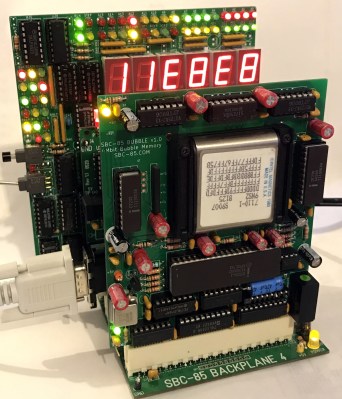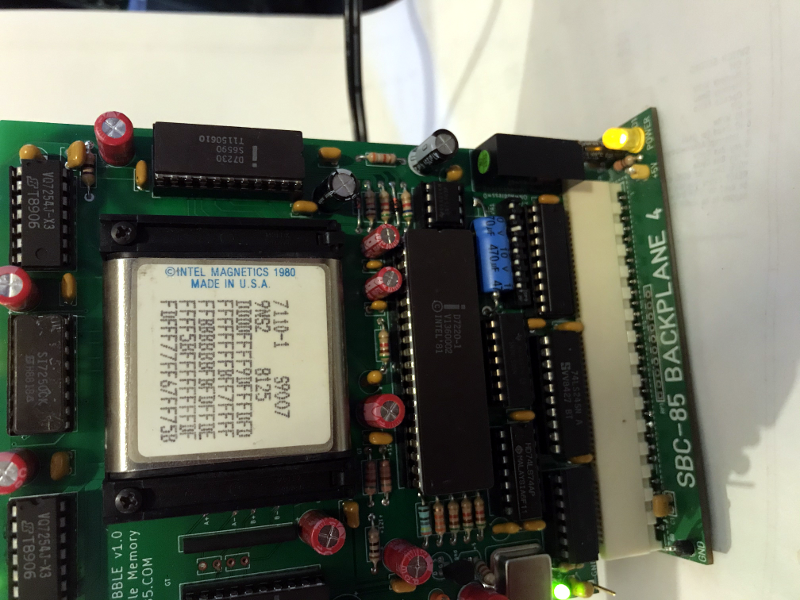There’s something both satisfying and sad about seeing an aging performer who used to pack a full house now playing at a local bar or casino. That’s kind of how we felt looking at [Craig’s] modern-day bubble memory build. We totally get, however, the desire to finish off that project you thought would be cool four decades ago and [Craig] seems to be well on the way to doing just that.
 If you don’t recall, bubble memory was going to totally wipe out the hard drive industry back in the late 1970s and early 1980s. A byproduct of research on twistor memory, the technology relied on tiny magnetic domains or bubbles circulating on a thin film. Bits circulated to the edge of the film where they were read using a magnetic pickup. Then a write head put them back at the other edge to continue their journey. It was very much like the old delay line memories, but with tiny magnetic domains instead of pressure waves through mercury.
If you don’t recall, bubble memory was going to totally wipe out the hard drive industry back in the late 1970s and early 1980s. A byproduct of research on twistor memory, the technology relied on tiny magnetic domains or bubbles circulating on a thin film. Bits circulated to the edge of the film where they were read using a magnetic pickup. Then a write head put them back at the other edge to continue their journey. It was very much like the old delay line memories, but with tiny magnetic domains instead of pressure waves through mercury.
We don’t know where [Craig] got his Intel 7110 but they are very pricey nowadays thanks to their rarity. In some cases, it’s cheaper to buy some equipment that used bubble memory and steal the devices from the board. You can tell that [Craig] was very careful working his way to testing the full board.
Because these were state-of-the-art in their day, the chips have extra loops and would map out the bad loops. Since the bubble memory is nonvolatile, that should be a one time setup at the factory. However, in case you lost the map, the same information appears on the chip’s label. [Craig’s] first test was to read the map and compare it to the chip’s printed label. They matched, so that’s a great sign the chip is in good working order and the circuit is able to read, at least.
We’ve talked about bubble memory before along with many other defunct forms of storage. There were a few military applications that took advantage of the non-mechanical nature of the device and that’s why the Navy’s NEETS program has a section about them.















“It was very much like the old delay line memories”
A shift register would be a better analogy. The bubbles would move from one site to the next only when commanded to do so by the magnetic field (from the two coils wrapping around the device).
Never really that useful. Once I worked out that starting at 1-2 deg C the magnetic domains would wander off they were useless. By -6deg C all the bits had gone walkabout. They were kinda power hungry so that might have kept them warm enough. By -6 deg they just got too cold for any internal heat to work. The application was high end (for late 1980’s) point of sale terminals.
The Intel apps engineer told me I still had all the ones and zeros, I just didn’t know which minority or even majority loop they belonged in.
When we canned the project Intel took all the devices back, it seems we only had a license to use. I still have one of the Garnet wafers and under a good microscope you can see the chevrons that the bubbles were stored in, but for some reason not the transfer gates.
Video on the SBC-85 1Mbit board— https://www.youtube.com/watch?v=yOe-iNIZR0E
If anyone has an intel multibus bubble Memory Board, I am interested in it, please don’t strip for parts.
Hi Craig, if still relevant to you, I have a complete Memtech PCI Bubble Card with 2x 7114-1 (20 pin, soldered to board). Recently rediscovered, I am contemplating listing it on eBay.
Hi Robert
The 7114 is the 4-MBit device and I have several of those ISA boards with one or two 7114 chips and support chips. What is missing to make them useful are any drivers and documentation. What *does* make them useful is the 7114 used the same 7254 H-bridge drivers as the 7110 1-MBit device. In fact it uses twice as many drivers as the 7110.
I have no plans of building a 4-MBit 7114 version of my bubble board, but who knows?
When I was in college, I built several wire wrap boards that adapted these bubble memory boards to an S-100 backplane. To the S-100 system this board looked like a floppy drive and ran software to control some very early CNC milling machines. I believe the company paying me was remilling the wheels on railroad car trucks. I did not design the board – I was merely copying the original a graduate student had built several years earlier. The original prototype still had all the software in its bubble memory after sitting unused for several years. The only other usage I ever saw of bubble memory was a non-volatile store for a GE (or GE-Fanuc) robot arm. Fun times in the 80’s.
We still have a CNC lathe at work with Fanuc 6T controls. Bubble memory and an Intel 8086 CPU. It’s still in daily use, and I bet that it’s going to be really fun to debug
“There’s something both satisfying and sad about seeing an aging performer who used to pack a full house now playing at a local bar or casino. ”
What’s old is new again.
https://spectrum.ieee.org/semiconductors/devices/introducing-the-vacuum-transistor-a-device-made-of-nothing
I like to use bubble memory as an example of how a hot new technology sometimes just doesn’t work out.
The problem was that people assumed with some advances in technology, bubble memory could eclipse conventional disk drives, but they just didn’t predict the advances yet to come in disk drive designs. They saw bubble memory passing up a stationary target, but it was actually moving fast.
Vintage Laptop using bubble memory:
http://oldcomputers.net/grid1101.html
Magnetic bubble memory was a very exciting idea. One article in Popular Science, which I read as a college kid in the 70s, said we would be able to fit all the music that had ever been recorded in a cigar box. According to some record industry guy there are about 100 million songs right now, which at reasonable quality (say 5-10 MB/song) would only take 5-10 terabytes. So we’ve already surpassed the cigar box point with a handful of flash drives you can get at Fry’s. And there are more exotic forms of storage, like 3-inch quartz crystal discs called “5D storage” that can hold more than 300 terabytes, probably forever.
Strangely enough, NewEgg has them.
https://www.neweggbusiness.com/product/product.aspx?item=9siv1w887a7798&bri=9b-1b4-008a-002p1
$1374 Hahahahahahahahahahaha.
Plus this is the 7110-1 leadless package and the Molex chip carriers no longer exist in the wild. Fortunately, the version 1.1 of this bubble board uses the much more common (20-pin) 7110A.